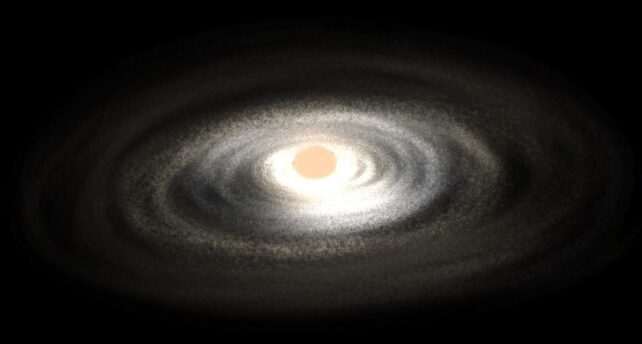In the early days of telescopic astronomy, researchers were limited to focusing on small sections of the sky at a time. This required manual observations and much of the significant work revolved around specific celestial objects such as nebulae, galaxies, quasars, and pulsars. However, modern telescopes now have the ability to capture wide areas of the sky simultaneously, coupled with automation to map the entire celestial sphere. Unlike early surveys which took years to complete, recent sky surveys can detect changes in just weeks or days. This capability is revolutionizing astronomy and leading to fascinating findings. For instance, an infrared sky survey has revealed previously unnoticed stars.  Artist’s impression of an eruption in the disc of matter around a newborn star. (Philip Lucas/University of Hertfordshire)The researchers conducted a series of papers published in the Monthly Notices of the Royal Astronomical Society, analyzing data from a decade-long survey called the Visible and Infrared Survey Telescope (VISTA), enabling them to monitor hundreds of millions of stars at infrared wavelengths. They focused on approximately 200 stars displaying the most significant changes in brightness, which can unveil subtle stellar dynamics. One goal was to identify very young stars in their early stages of transitioning into fusion-powered stars. Within this group, they found 32 erupting protostars, experiencing rapid brightness increases of up to a factor of 300, occurring within the surrounding matter disc. These outbursts, lasting months or years, can boost young star growth while potentially affecting planet formation. They referred to these turbulent protostars as “squalling newborns.” Additionally, the team identified 21 red giant stars in the center of our galaxy undergoing substantial brightness changes. They identified them as a new type of red giant known as “old smokers.” These red giants, rich in heavy elements, can emit clouds of dust, temporarily obscuring their brightness and then reappearing as the clouds disperse. This discovery could reshape our understanding of heavy element distribution in the galaxy. This article was originally published by Universe Today. Read the original article.
Artist’s impression of an eruption in the disc of matter around a newborn star. (Philip Lucas/University of Hertfordshire)The researchers conducted a series of papers published in the Monthly Notices of the Royal Astronomical Society, analyzing data from a decade-long survey called the Visible and Infrared Survey Telescope (VISTA), enabling them to monitor hundreds of millions of stars at infrared wavelengths. They focused on approximately 200 stars displaying the most significant changes in brightness, which can unveil subtle stellar dynamics. One goal was to identify very young stars in their early stages of transitioning into fusion-powered stars. Within this group, they found 32 erupting protostars, experiencing rapid brightness increases of up to a factor of 300, occurring within the surrounding matter disc. These outbursts, lasting months or years, can boost young star growth while potentially affecting planet formation. They referred to these turbulent protostars as “squalling newborns.” Additionally, the team identified 21 red giant stars in the center of our galaxy undergoing substantial brightness changes. They identified them as a new type of red giant known as “old smokers.” These red giants, rich in heavy elements, can emit clouds of dust, temporarily obscuring their brightness and then reappearing as the clouds disperse. This discovery could reshape our understanding of heavy element distribution in the galaxy. This article was originally published by Universe Today. Read the original article.
Astronomers Discover a Previously Unseen Type of Star













